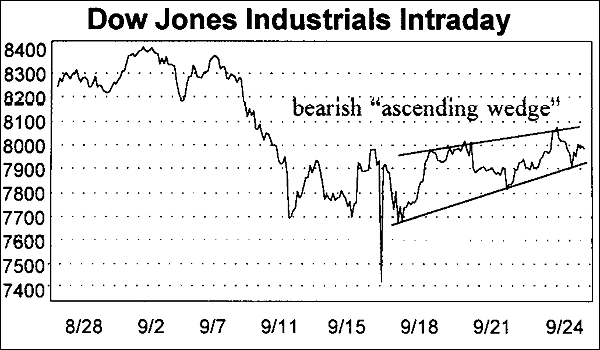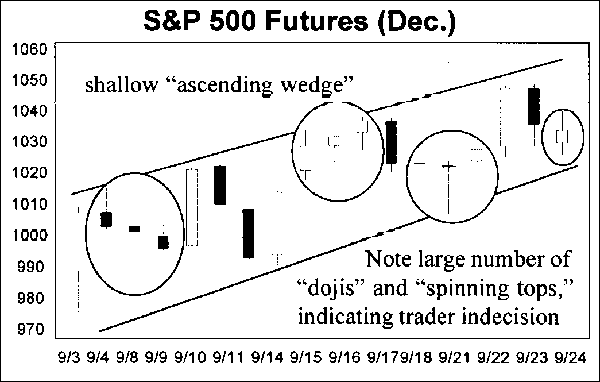Dow Approaches Apex of Bearish "Ascending Wedge"
Long-time readers of this commentary will have noticed the large emphasis we place on geometric patterns formed in the stock charts. Unlike most stock commentators, our emphasis on salient technical features of stock charts far eclipses any mention we may make of the market's "fundamentals."
Our primary purpose in this exercise is not to tax the reader's mind with excessive technical considerations. Instead, we try to present a comprehensive picture of the stock market's near-term trend using the single most valuable element of stock market (or any form of economic) analysis: pattern recognition. It has often been stated that "timing is everything." Not quite. Pattern recognition is primary, timing is concomitant to this.
Thus, it should come as no surprise that we make reference to a geometric technical pattern in this week's headline. The extremely important and portentous "ascending wedge" formation we have constantly referred to in the past couple of weeks appears to be nearing its apex, which presages a sharp move to the downside in the Dow Industrials as well as the other major indexes. Cycles, momentum indicators, oscillators, moving averages,

Elliott Waves, Fibonacci ratios—all of these, while important in their own right, can effectively be ignored in place of this one prominent chart pattern. And, as investors around the country will shortly discover, ascending wedges do not bode well for the health of the stock market.
Yet another ascending wedge pattern presents itself in the S&P 500 futures chart (basis December). Note our accompanying candlestick chart which shows several "dojis" and "spinning tops," candlestick formations which reflect trader indecision and usually harbinger abrupt changes in the market's near-term course. In this case, we would expect that change to be to the downside.

Our ascending wedge quite clearly appears on the verge of exhaustion, and it may have already peaked. We accurately predicted last week that a touch of its trendline top at approximately DJ 8175 would send the Dow plummeting quickly and sharply downward (though the Dow's fall of Thursday, Sept. 24 didn't quite measure up to expectations in the way of severity). Nevertheless, prices have worked their way toward the tip, or apex, of the wedge and should commence falling toward our cited Gann support level of DJ 6975 this week, possibly even on Monday the 28th. Admittedly, this is a bold assumption in light of Federal Reserve Chairman Greenspan's coming interest rate announcement on Sept. 29, but it is not out of the question and from a technical standpoint should be given preeminence as the most likely scenario.
Speaking of interest rates, it is our fervent belief that interest rates will NOT be cut this time by the Fed (though it is a possibility). Contrary to mass media speculation, Chairman Greenspan, in our view, has given no such "strong indication" that he will cut short-term rates. In fact, most economists and policy experts close to the Fed have intimated that the Fed will not cut them (many, in fact, have advised the Fed not to cut rates). However, even if rates are cut this will have NO, repeat, NO lasting impact on the stock market. Investors may react immediately to the Fed's interest rate announcement (whatever it may be) and stocks may react positively or negatively—perhaps even violently—but the impact will last for only one-to-two days. This is the way it is with any Fed announcement.
On every occasion Greenspan has proffered his opinion on the state of the economy or the stock market, the effects have rarely been for more than one day. (The most notable example of this was Greenspan's infamous "irrational exuberance" comment in December 1996, which caused the Dow to plummet for the day, but it recovered the next day. More recently, Greenspan's comments hinting at a possible interest rate cut elicited a euphoric surge in most global stock market indices, but the next day markets here and overseas continued their falling trend).
All of this plays off a little-known but extremely useful truism—news does not effect the stock market for any length of time because by the time the "news" becomes common knowledge it is no longer new. The stock market is the closest thing we have to a crystal ball as it foresees and discounts nearly all future events ahead of time and makes adjustments in stock prices accordingly. Thus, if the Fed indeed decides to cut rates we can all be sure the market long ago adjusted to this, and we can expect no major changes in the market's course based on any such announcement by the Fed.
Returning to our analysis, we find a number of technical and cyclical indicators that support our prediction of a steep sell-off in the markets during the coming week. Several bear market cycles are scheduled to kick in this week and this should exacerbate any existing bearishness in the indices. The level of equity call volume on the CBOE has generally exceeded equity put volume by a large degree over the past week, a bearish indicator. The Dow Jones Industrial Average along with the IBD Mutual Fund Index are both below their 200-day moving averages by considerable levels—also bearish.
Other leading technical indicators are flashing bearish signals as well. For example, John T. Goddess, editor of The Master Indicator (11371 Torchwood Ct., Wellington, FL 33414), has pointed out in a recent issue of his newsletter that indicator showing intermediate-term selling pressures (I-SP) is showing a bearish reading. Momentum indicators are also pointing decisively downward, presaging continued market declines in the weeks ahead.
On another front, insider selling, as measured and reported by CDA/Investnet, has picked up considerably in the past month and this does not bode well for the remaining bulls. According to the latest statistics released by the group, institutional selling has led buying among institutional money managers by a ratio of nearly four-to-one. Top corporate sellers include MCI Communications, EMC, Eli Lilly, Procter & Gamble, and Tandy.
Our analysis would not be complete without commenting on the recent trends in popular culture. The Beanie Baby craze, which has run parallel to the bubble for stocks over the past two years, appears to be ending along with the stock market craze. According to an article appearing in the Sept. 25 Wall Street Journal, Beanie Babies are rapidly losing monetary values as collector items as children and collectors around the country seek to take profits on their "investments," apparently in a mass realization that the inflated values of the dolls are not realistic.
"Small children began to believe in the reported prices as actual value—turning them into pint-sized images of their stock market-crazed parents," the Journal observed. The article goes on to state that most collectors in this craze apparently could not distinguish between actual and imputed value—an important distinction when it comes to investing. "They're all bubbles," said one economist quoted in the article, recognizing the uncanny resemblance between the Beanie Baby fad the stock market mania.
But as most of our readers know, both crazes are consistent with the irrational manifestations of mass psychology. While the Beanie Baby craze may seem unrelated to stock market trends, it is actually an important reflection of the psychology that drives all speculative "bubbles." The collapse of the Beanie Baby phenomenon is showing us that all trends must come to an end, and the trend toward ever-higher prices—in the stock market and the Beanie Baby market—is coming to an end.


















